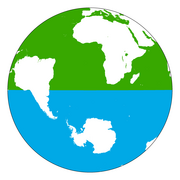The land hemisphere and water hemisphere are the hemispheres of Earth containing the largest possible total areas of land and ocean, respectively. By definition (assuming that the entire surface can be classed as either "land" or "ocean"), the two hemispheres do not overlap.
Determinations of the hemispheres vary slightly. One determination places the centre of the land hemisphere at 47°13′N 1°32′W / 47.217°N 1.533°W (in the city of Nantes, France).[1] The centre of the water hemisphere is the antipode of the centre of the land hemisphere, and is therefore located at 47°13′S 178°28′E / 47.217°S 178.467°E (near New Zealand's Bounty Islands in the Pacific Ocean).
An alternative assignment determines the centre of the land hemisphere to be at 47°24′42″N 2°37′15″W / 47.411667°N 2.620833°W (in Île Dumet near Piriac-sur-Mer, France).[2][3] The centre of the water hemisphere is located at 47°24′42″S 177°22′45″E / 47.411667°S 177.379167°E (near New Zealand's Bounty Islands in the Pacific Ocean). In comparison the geographic center of the Pacific Ocean, the main ocean of the water hemisphere, is further north-east, in eastern Kiribati south of Kiritimati, just west from Starbuck Island at 4°58′S 158°45′W / 4.97°S 158.75°W.[4] The oceanic pole of inaccessibility, known as Point Nemo and for being the so-called spacecraft cemetery, lies east at 49°01′38″S 123°26′04″W / 49.0273°S 123.4345°W.
YouTube Encyclopedic
-
1/5Views:179 740576 4851 756 891229 5991 767 324
-
The Four Hemispheres of the Earth
-
The Southern Hemisphere is Colder, Stormier, and... Cleaner?
-
Does Water Swirl the Other Way in the Southern Hemisphere?
-
The Seasons and Hemispheres | LEARNING WITH SARAH | Educational videos for Kids
-
Know Your Globe
Transcription
Distribution of geographical features
The land hemisphere has the substantial majority of the planet's land (80.1 percent), including nearly all of Asia (with Maritime Southeast Asia being the only notable exception) and most of South America. Africa, Europe, and North America are solely within the land hemisphere. However, even in the land hemisphere, the water area still slightly exceeds the land area (with 53 percent water to 47 percent land). This hemisphere is almost identical to the hemisphere containing the greatest human population.[5] The land hemisphere also contains most of Earth's inland waters, including the African Great Lakes, Eurasia's Caspian Sea, the Great Lakes of North America, and Lake Baikal in Siberia.
The water hemisphere has only about one-fifth of the world's land, including Easter Island, the Hawaiian Islands, other Pacific islands, Maritime Southeast Asia, the southern tip of the Indochinese Peninsula, the southern portion of the Malay Peninsula, the Ryukyu Islands, Taiwan, and the Southern Cone of the Americas. Antarctica, Australia, and Zealandia are solely within the water hemisphere. Some sources[1] further divide land into "dry land" and "ice cap". Antarctica provides the water hemisphere with the majority of Earth's ice.
Most of the Pacific Ocean and the Indian Ocean, and the whole Southern Ocean, are in the water hemisphere. The water hemisphere is approximately 89 percent water (almost all pertaining to the World Ocean), 6 percent dry land and 5 percent polar ice cap.[1]
The table below shows Alphonse Berget's estimates of the land area in each continent in the land and water hemispheres.[2]
| Continent | Land area within each hemisphere km2 (sq mi) | |
|---|---|---|
| Land | Water | |
| Africa | 29,818,400 (11,512,949) | 0 (0) |
| Americas | 34,955,670 (13,496,460) | 3,391,010 (1,309,276) |
| Antarctica | 0 (0) | 13,120,000 (5,065,660) |
| Asia | 40,897,241 (15,790,513) | 3,245,649 (1,253,152) |
| Europe | 9,732,250 (3,757,643) | 0 (0) |
| Oceania | 0 (0) | 8,958,630 (3,458,946) |
| Total land area | 115,403,561 (44,557,564) | 28,715,289 (11,087,035) |
See also
References
- ^ a b c Boggs, Samuel Whittemore (December 1945). "This Hemisphere". Journal of Geography. 44 (9): 345–355. doi:10.1080/00221344508986498.
- ^ a b Berget, Alphonse (1913). "Répartition géographique des Océans (détermination du pôle continental)". Annales de l'Institut océanographique. 10 (in French). V.
- ^ "L'ILE DUMET: LE NOMBRIL DU MONDE". France Secret (in French). Archived from the original on 10 November 2013.
- ^ "International Journal of Oceans and Oceanography, Volume 15 Number 1, 2021, Determining the Areas and Geographical Centers of Pacific Ocean and its Northern and Southern Halves, pp 25-31, Arjun Tan". Research India Publications. Retrieved 2022-07-18.
- ^ "How Much of Humanity is on Your Side of World?". Brilliant Maps. 27 September 2015. Retrieved 12 December 2016.




